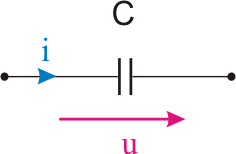A capacitor is a dipole which can store electrical energy by means of an electrical field.
A capacitor is characterized by the capacity C, which depends on the dielectric constant of the insluating material  (electrical permittivity), on the surface of the conducting armatures A and on the distance d between the armatures, as in the relation:
(electrical permittivity), on the surface of the conducting armatures A and on the distance d between the armatures, as in the relation:

The symbol of a capacitor and the reference directions of the voltage and of the current (convention as load) are:

Figure 9 - Symbolic representation of the capacitor and the reference directions
The measurement unit of the capacity C of a condenser is the Farad (  ) and, considering the previous expression, it is positive.
) and, considering the previous expression, it is positive.
In the absence of physical displacement of the element, the current that passes through a capacitor is in direct proportion with the time derivative of the voltage at its terminals, multiplied by C:

Similarly to the inductance, a first remark that can be made in relation to the above expression is that, if the voltage  is constant in time, the current that passes through it is zero. This situation corresponds to the reaching of the steady state regime in a DC supplied circuit; In this situation, a capacitor is the equivalent of an open circuit,
is constant in time, the current that passes through it is zero. This situation corresponds to the reaching of the steady state regime in a DC supplied circuit; In this situation, a capacitor is the equivalent of an open circuit,  .
. 
In relation to the power at the terminals of a capacitor, we can write:

Similarly to an inductance, the sign of the power at the terminals of a capacitor depends on the signs of the voltage and of its derivative; this means that a capacitor can absorb or provide energy.
The energy  that passes through the capacitor can be calculated:
that passes through the capacitor can be calculated:
 ,
,
in which  is the enegy stored at the moment
is the enegy stored at the moment  .
.
Considering the reference directions of the voltage and of the current corresponding to the convention as load, we can observe:
• if  (the voltage at the terminals and its derivative have the same sign), the capacitor will absorb energy, rising the energy stored;
(the voltage at the terminals and its derivative have the same sign), the capacitor will absorb energy, rising the energy stored;
• if  (the voltage at the terminals and its derivative have different signs), the capacitor provides energy, giving back the stored energy.
(the voltage at the terminals and its derivative have different signs), the capacitor provides energy, giving back the stored energy.